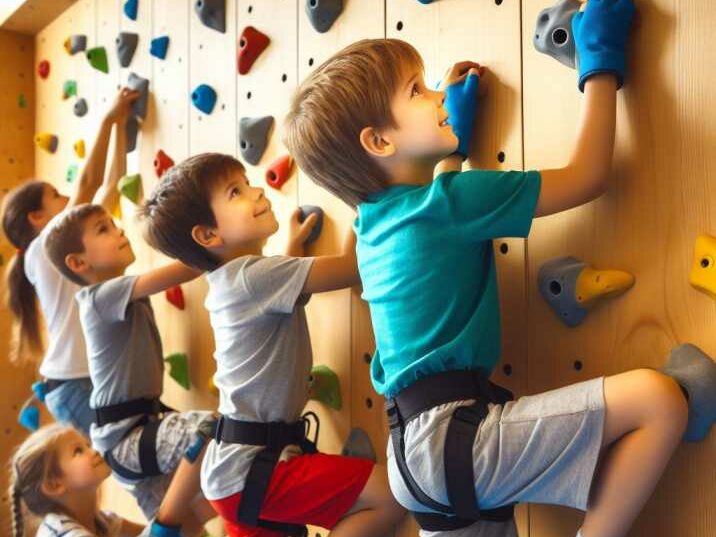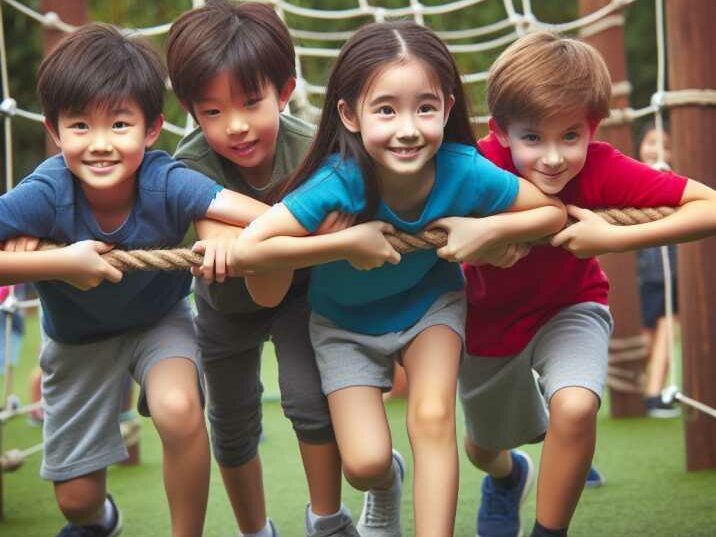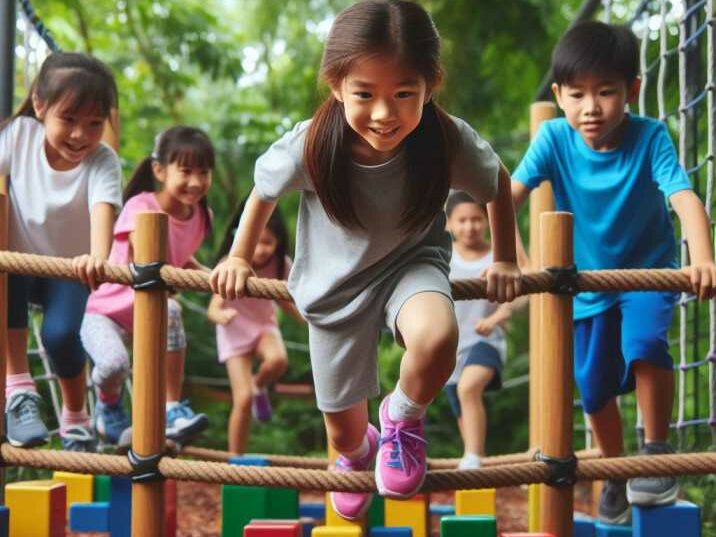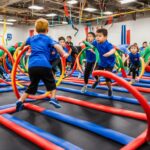Power of 5 Obstacle Courses for Kids
Table of Contents
Introduction:
In the age of smartphones and video games, getting kids off the couch and engaged in physical activity can be a daunting task. However, the solution might be simpler (and more fun) than you think. Obstacle course training for kids has emerged as a game-changer in promoting physical fitness while instilling valuable life skills. In this article, we’ll explore the fascinating world of obstacle course training and delve into its profound impact on the physical fitness of our young ones.
The Evolution of Obstacle Course Training:
Obstacle course training is not a new concept. Historically, it has been a part of military training programs, fostering resilience, strength, and agility. Today, this concept has been adapted for children, transforming mundane exercise routines into thrilling and challenging adventures.
The Elements of Obstacle Courses:
One of the key reasons obstacle courses are so effective is their ability to engage multiple muscle groups simultaneously. These courses typically include a variety of elements such as climbing walls, balance beams, tunnels, and monkey bars. Each element targets specific muscle groups, promoting overall strength and coordination.
Building Strength and Endurance:
Obstacle course training is a fantastic way to build both strength and endurance in kids. Climbing over walls, crawling under nets, and swinging on monkey bars require a combination of upper body, core, and lower body strength. Additionally, the continuous nature of the course helps improve cardiovascular endurance, laying the foundation for a healthy heart and lungs.

Enhancing Motor Skills and Coordination:
Navigating through obstacle courses demands precision and coordination. Kids learn to control their movements, refine their motor skills, and develop a keen sense of spatial awareness. These skills not only contribute to better physical fitness but also translate into improved performance in various daily activities and sports.
Boosting Confidence and Resilience:
Overcoming obstacles, both physical and mental, fosters a sense of accomplishment and boosts self-esteem. When a child successfully conquers a challenging course, they develop confidence in their abilities. This newfound confidence extends beyond the course, influencing their approach to other challenges they may encounter in life.
Social Development:
Obstacle courses are often designed to be completed in groups, encouraging teamwork and cooperation. Children learn to communicate effectively, share ideas, and support each other through the course. This social aspect not only enhances the overall experience but also contributes to the development of crucial interpersonal skills.

Preventing Childhood Obesity:
Childhood obesity is a growing concern, and finding ways to keep kids active is more critical than ever. Obstacle course training offers a fun and engaging solution. By making exercise enjoyable, kids are more likely to stay active and develop lifelong habits that promote a healthy lifestyle, reducing the risk of obesity-related health issues.
Adaptable for All Fitness Levels:
One of the beauty of obstacle courses is their adaptability. Courses can be designed with varying levels of difficulty, making them suitable for children of all fitness levels. Whether a child is a seasoned athlete or just starting their fitness journey, they can find a course that challenges them appropriately.
Creating Lifelong Fitness Habits:
The goal of obstacle course training extends beyond the immediate physical benefits. By making exercise enjoyable and integrating it into a child’s routine, we set the stage for lifelong fitness habits. When kids associate physical activity with fun and excitement, they are more likely to continue being active throughout their lives.
Conclusion:
Obstacle course training is more than just a physical activity; it’s a holistic approach to promoting the overall well-being of our children. By targeting physical fitness, motor skills, confidence, and social development, obstacle courses offer a multifaceted solution to the challenges posed by sedentary lifestyles. As parents, educators, and caregivers, let’s embrace this innovative and enjoyable approach to ensure our kids grow up healthy, confident, and ready to face life’s obstacles head-on. Obstacle course training isn’t just a trend; it’s a transformative journey toward a healthier and more active future for our children.

Frequently Asked Questions (FAQs)
- What age group is ideal for obstacle course training in kids? Obstacle course training is generally suitable for a wide age range, but it’s essential to consider age-appropriate challenges. Younger children may start with simpler courses focused on balance and coordination, while older kids can tackle more complex obstacles.
- How can parents integrate obstacle course elements at home for their kids? Parents can easily create a mini obstacle course using household items like cushions, chairs, and hula hoops. This not only adds an element of fun to daily activities but also promotes physical activity in a familiar environment.
- Are there any safety considerations for kids participating in obstacle course training? Safety is paramount. Ensure the course is age-appropriate, use proper protective gear, and supervise the kids during the activity. Additionally, choose surfaces that minimize the risk of injuries in case of falls.
- What role does mental resilience play in obstacle course training for kids? Obstacle courses challenge both the body and the mind. Kids learn to overcome obstacles, fostering mental resilience and perseverance. This mental toughness developed during training can positively impact various aspects of their lives.
- Can children with varying fitness levels participate in the same obstacle course? Absolutely. Many courses are designed with different difficulty levels, allowing children of varying fitness levels to participate. This inclusivity ensures that every child can enjoy the benefits of obstacle course training.
- How frequently should kids engage in obstacle course training for optimal results? The frequency of obstacle course training can vary based on the child’s age and fitness level. However, incorporating it into a weekly routine, perhaps two to three times a week, can contribute significantly to physical fitness.
- What are some creative obstacle course elements that kids particularly enjoy? Kids love variety. Incorporate elements like crawling tunnels, rope swings, and stepping stones to keep the course engaging. The more creative and enjoyable the obstacles, the more likely kids are to stay active and interested.
- Can obstacle course training help in developing teamwork skills in kids? Absolutely. Many obstacle courses are designed for group activities, fostering teamwork and cooperation. Children learn to communicate, collaborate, and support each other, laying the groundwork for strong interpersonal skills.
- How does obstacle course training contribute to a child’s academic performance? Physical activity has been linked to improved cognitive function. Obstacle course training, with its focus on coordination and problem-solving, can positively impact a child’s ability to concentrate and perform well academically.
- Are there any indoor alternatives for obstacle course training during bad weather? Indoor obstacle courses can be just as exciting. Use soft, lightweight materials to create challenges that can be navigated indoors, ensuring that kids can stay active even when the weather isn’t conducive to outdoor activities.
- What are the signs that a child is benefiting from obstacle course training? Look for increased confidence, improved motor skills, and a growing enthusiasm for physical activity. Children who benefit from obstacle course training often showcase better coordination and a more positive attitude toward challenges.
- How can schools incorporate obstacle course training into physical education programs? Schools can integrate obstacle courses into their physical education curriculum by designing age-appropriate courses and conducting organized events. This not only promotes physical fitness but also introduces an element of excitement to traditional physical education classes.


